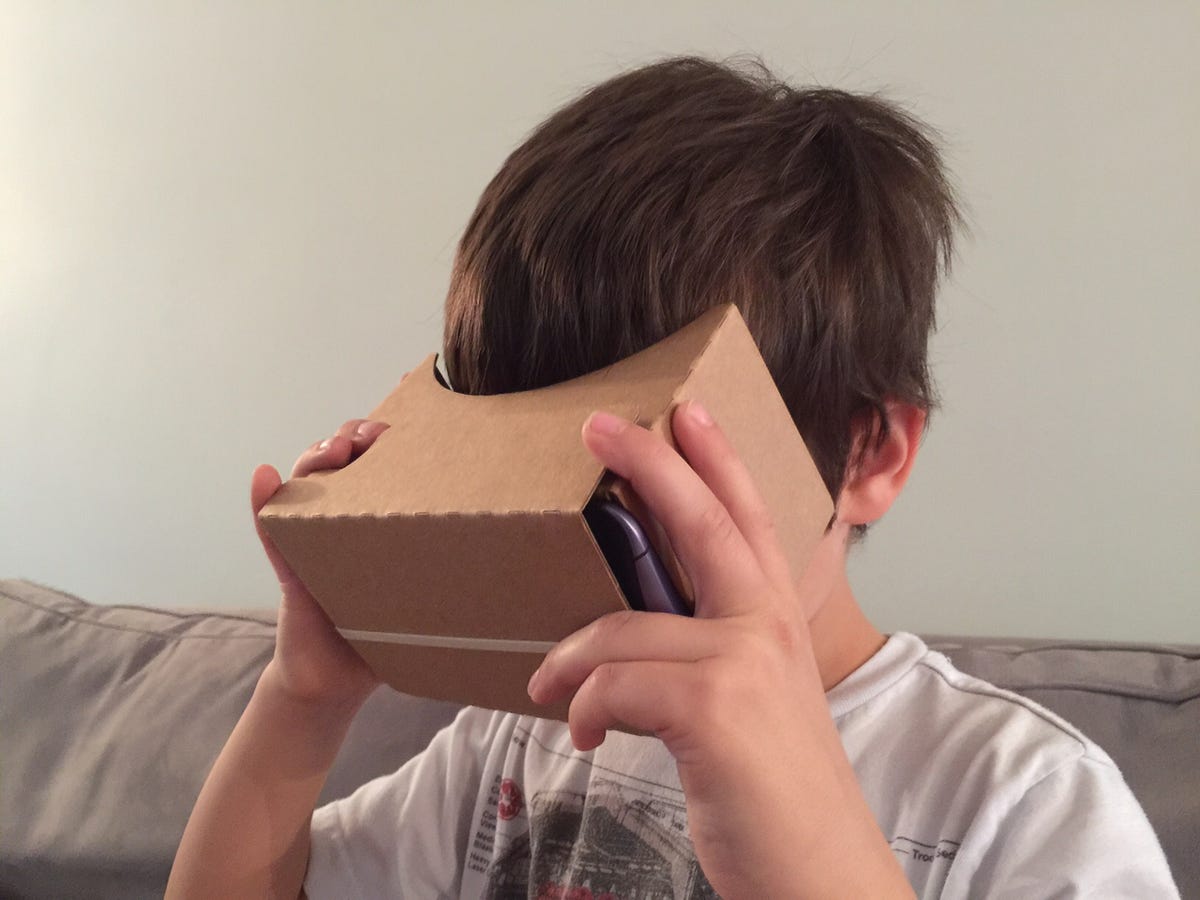
Scott Stein/CNET
My 6-year old son tried on the folded cardboard pair of goggles as I sat next to him on the sofa. My iPhone 6 Plus was in it, running Google’s Cardboard app, the company’s virtual-reality (VR) software long available on Android and just released on iOS. I loaded a panorama of the Museum of Natural History — his favorite dinosaur room.
“Look around. Click to go to other places.” I watched his face light up. “Where are you?”
“Wow. Is this the moon?”
No, I told him. It was Mars.
It’s always been clear to me that kids would like VR. But that’s doubly true with Google Cardboard , Google’s extremely clever low-rent approach to virtual reality. After debuting at 2014’s Google I/O developer conference, it’s come back in a refined version with more apps, and it works with more phones. And now, it’s trying to appeal to kids, and schools in particular.


James Martin/CNET
I remember loving ViewMaster goggles, and 3D glasses and dreams of worlds in secret doorways. VR is a pair of magic glasses. That’s the way my son thinks of them: Dad’s magic goggles. I let him try the Oculus-developed Samsung Gear VR last winter, along with his cousins. They loved Tony Stark’s lab, but were amazed and slightly scared by the sharks and giant whales.
Would you like this at your school? I asked him. He nodded with a big smile (of course he did; what kid wouldn’t?). After a few minutes, he said: “I think this should be kid-famous, but not world-famous.” I asked him what he meant. “It would be famous for kids, but not for grown-ups. Just like that one you use that grown-ups use but kids can’t.”
He was referring to Gear VR.
Oculus, the leading presence in virtual reality over the last several years, never did much to connect VR and children. In fact, the Oculus Rift and the Gear VR weren’t recommended for younger kids. That’s not entirely odd: Nintendo’s 3DS handheld wasn’t recommended for children 6 and under when using 3D mode. Oculus may indeed shift focus to kids, too, by the time the Oculus Rift debuts next year: a preview of the new VR film “Henry” shows a Pixar-like story and adorable characters. But right now, my Gear VR isn’t stuffed with kid-friendly apps.
And yet, I used 3D ViewMaster toys when I was little. I loved seeing things in 3D. (Maybe not surprisingly, ViewMaster’s being reborn as a Google Cardboard-compatible VR viewer for kids this fall.) And Google Cardboard doesn’t set any clear age limitations for its hardware, although apps of course have their own content-based ratings.


CNET
Google’s Cardboard, the little folded-cardboard VR viewer that works with just about any phone, is the first VR platform targeted at children. At Google’s I/O developers conference, a video featuring children on a virtual school field trip earned some oohs. An upcoming school-targeted kit called “Expeditions” includes pairs of foldable goggles, and all the rest of gear needed to bring your class to places in full panoramic 3D.
Cardboard isn’t as good as Oculus’ highly tuned headsets and (PC-based) hardware, but it’s good enough to make everyday tech fans get excited. I brought a pair of the new Cardboard back to CNET’s San Francisco office, and people handed it around, even gasping at the experience. Most people haven’t used VR at all. Google Cardboard is a cheap, amazing way to give it a go.
But for kids, it could be a whole different level of excitement. Cardboard is cheap, which — like ultra-affordable Chromebooks — is good for schools that can’t afford to fold much tech into their budget. (Even if you factor in the cost of the phones, it’s still far more affordable than the Oculus Rift, and even the Gear VR.) And it’s casual: there’s no strap on the back to lock Cardboard on your head. You take it on and off, like a pair of binoculars. It’s a tool, not a full-immersion device. And for a classroom, that makes total sense.


Scott Stein/CNET
I wonder what my son dreams of when he sees VR, at the age of 6. Some of it scares him, some of it amazes him. He read out loud that he was seeing Venice, New York City and caves. He asked me if there was an outer-space app. I didn’t have one (but there is one, on Android: Titans of Space, and it’s free). He understood it. And he liked exploring with it.
If I could let my son see far-off places, extinct animals, microscopic molecules, works of sculpture and natural vistas in full 3D, and do it right at home, why wouldn’t I let him? VR is mostly curated, uniquely created content. It can illustrate a sense of scale and scope better than an illustration or a video. It’s a tool. It’s not a replacement for tradition. But it could be a great addition. And if classrooms start using it, how fast will Google’s cardboard VR world grow?
Once Google seeds Cardboard with more apps and videos via YouTube , it could become the only virtual reality kids know.



